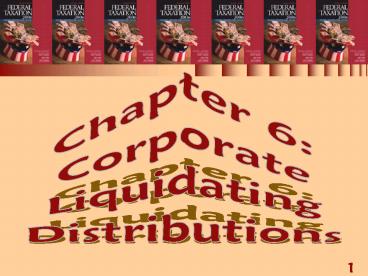Chapter 6: Corporate Liquidating Distributions - PowerPoint PPT Presentation
1 / 21
Title:
Chapter 6: Corporate Liquidating Distributions
Description:
Basis of property received is FMV on distribution date ... Property distributed pro rata to all s/h ... Distribution(s) w/in a single tax year ... – PowerPoint PPT presentation
Number of Views:325
Avg rating:3.0/5.0
Title: Chapter 6: Corporate Liquidating Distributions
1
Chapter 6Corporate Liquidating Distributions
Chapter 6 Corporate Liquidating Distributions
2
LIQUIDATING DISTRIBUTIONS
- Complete liquidation vs. dissolution
- Effects of liquidation on shareholders
- Effects of liquidation on liquidating corporation
- Liquidation of a controlled subsidiary
- Special shareholder issues
- Debt retirement
3
Complete Liquidation vs. Dissolution (1 of 3)
- Complete liquidation
- Completely cancel or redeem all of corps stock
in accordance with plan of liquidation OR - One of a series of distributions in accordance
with plan of liquidation
4
Complete Liquidation vs. Dissolution (2 of 3)
- Liquidation status
- Corporation ceases to be going concern
- Activities for purpose of winding up its affairs,
paying debts, distributing remaining property
to shareholders - Retention of nominal assets does not alter
liquidation status
5
Complete Liquidation vs. Dissolution (3 of 3)
- Dissolution of corporation
- A legal action that requires corporation to
surrender its charter to the state - Possible to liquidate corporation without
dissolving it - Dissolution frees corporate name for use by
others
6
Effects of Liquidation on Liquidating Shareholders
- Amount of recognized gain or loss
- Character of gain or loss
- Basis of property received by shareholder
- See Table C6-1 for a summary
7
Amount of Recognized Gain/Loss
- Shareholder assumed to have sold stock for FMV of
net assets received - FMV of assets - liabilities received
- - Basis of stock surrendered
- Amount of gain (loss) recognized
8
Character of Gain/Loss
- General rule
- Gain or loss treated as capital transaction
- Exceptions
- 1244 stock receives ordinary loss treatment
(subject to limitations) - Losses sustained by a parent in a worthless stock
investment in a controlled subsidiary receive
ordinary loss treatment
9
Basis of Property Received by Shareholder
- General liquidation rules
- Basis of property received is FMV on distribution
date - Holding period starts day after distribution date
10
Effects of Liquidation on Liquidating Corporation
- Recognition of gains/losses
- Liabilities assumed by shareholders
- Exceptions to general rule
- See Table C6-2 for a summary
11
Recognition of Gains/Losses
- General rule
- Both gains losses recognized
- Tax attributes disappear
12
Liabilities Assumed by Shareholders
- General rule
- Distributed assets valued at FMV
- Rule when liability exceeds FMV of related asset
distributed - FMV of related asset cannot be less than amount
of liability assumed or acquired
13
Exceptions to General Rule(1 of 2)
- Distributions to related parties
- No loss recognized by corp unless
- Property distributed pro rata to all s/h
- Property NOT acquired by capital contribution or
351 w/in past five years - Gains recognized in accordance with general rule
14
Exceptions to General Rule(2 of 2)
- Tax-avoidance purpose
- Losses disallowed if primary purpose of
acquisition of property in 351 transfer or
capital contribution was to produce losses to
offset gains from the liquidation of other
property - Rule also applies to sales, exchanges, or other
distributions of such property
15
Liquidation of a Controlled Subsidiary
- Requirements for liquidation of subsidiary into
parent - Effects of liquidation on shareholders
- Effects of liquidation on subsidiary
16
Requirements for Liquidation of Subsidiary into
Parent (1 of 2)
- Parent owns ? 80 of voting power AND value of
stock - Must be complete cancellation or redemption of
subsidiarys stock - Distribution(s) w/in a single tax year
- Or qualify as one of a series of distributions
completed w/in three years after year of first
distribution
17
Requirements for Liquidation of Subsidiary into
Parent (2 of 2)
- Subsidiary must be solvent
- Nonrecognition does not apply to minority
stockholders - Nonrecognition does not apply if parent receives
payment to satisfy subsidiarys indebtedness to
parent
18
Effects of Liquidation on Shareholders (1 of 2)
- Effects on parent corporation
- Tax attributes carry over to parent including
basis and holding period - Types of tax attributes
- Potential for depreciation recapture
- NOL carryovers
- Earnings and profits balance
- Capital loss carryovers
- General business other tax credits
19
Effects of Liquidation on Shareholders (2 of 2)
- Effects on minority shareholders
- Taxed under general liquidation rules under 331
- No carryover of basis or holding period
20
Effects of Liquidation on Subsidiary
- Special rule for controlled subsidiary
- No gain or loss recognized when controlled
subsidiary transfers its assets and liabilities
to parent corp
21
End of Chapter 6
Comments or questions about PowerPoint
Slides?Contact Dr. Richard Newmark atUniversity
of Northern ColoradosKenneth W. Monfort College
of Businessrichard.newmark_at_PhDuh.com































